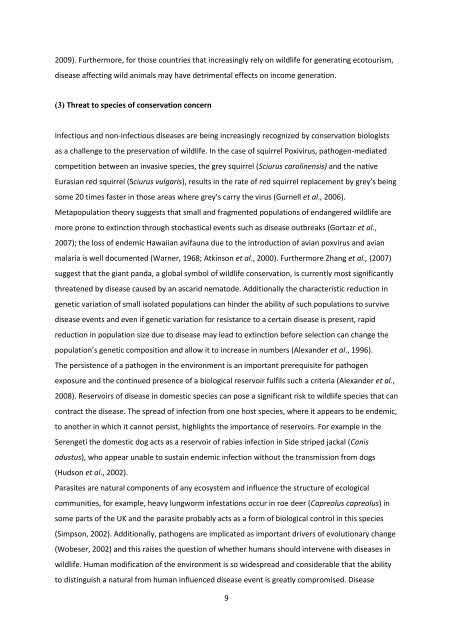Developing an oral bait for badger vaccination - Exeter Research ...
Developing an oral bait for badger vaccination - Exeter Research ...
Developing an oral bait for badger vaccination - Exeter Research ...
Create successful ePaper yourself
Turn your PDF publications into a flip-book with our unique Google optimized e-Paper software.
2009). Furthermore, <strong>for</strong> those countries that increasingly rely on wildlife <strong>for</strong> generating ecotourism,<br />
disease affecting wild <strong>an</strong>imals may have detrimental effects on income generation.<br />
(3) Threat to species of conservation concern<br />
Infectious <strong>an</strong>d non-infectious diseases are being increasingly recognized by conservation biologists<br />
as a challenge to the preservation of wildlife. In the case of squirrel Poxivirus, pathogen-mediated<br />
competition between <strong>an</strong> invasive species, the grey squirrel (Sciurus carolinensis) <strong>an</strong>d the native<br />
Eurasi<strong>an</strong> red squirrel (Sciurus vulgaris), results in the rate of red squirrel replacement by grey’s being<br />
some 20 times faster in those areas where grey’s carry the virus (Gurnell et al., 2006).<br />
Metapopulation theory suggests that small <strong>an</strong>d fragmented populations of end<strong>an</strong>gered wildlife are<br />
more prone to extinction through stochastical events such as disease outbreaks (Gortazr et al.,<br />
2007); the loss of endemic Hawaii<strong>an</strong> avifauna due to the introduction of avi<strong>an</strong> poxvirus <strong>an</strong>d avi<strong>an</strong><br />
malaria is well documented (Warner, 1968; Atkinson et al., 2000). Furthermore Zh<strong>an</strong>g et al., (2007)<br />
suggest that the gi<strong>an</strong>t p<strong>an</strong>da, a global symbol of wildlife conservation, is currently most signific<strong>an</strong>tly<br />
threatened by disease caused by <strong>an</strong> ascarid nematode. Additionally the characteristic reduction in<br />
genetic variation of small isolated populations c<strong>an</strong> hinder the ability of such populations to survive<br />
disease events <strong>an</strong>d even if genetic variation <strong>for</strong> resist<strong>an</strong>ce to a certain disease is present, rapid<br />
reduction in population size due to disease may lead to extinction be<strong>for</strong>e selection c<strong>an</strong> ch<strong>an</strong>ge the<br />
population’s genetic composition <strong>an</strong>d allow it to increase in numbers (Alex<strong>an</strong>der et al., 1996).<br />
The persistence of a pathogen in the environment is <strong>an</strong> import<strong>an</strong>t prerequisite <strong>for</strong> pathogen<br />
exposure <strong>an</strong>d the continued presence of a biological reservoir fulfils such a criteria (Alex<strong>an</strong>der et al.,<br />
2008). Reservoirs of disease in domestic species c<strong>an</strong> pose a signific<strong>an</strong>t risk to wildlife species that c<strong>an</strong><br />
contract the disease. The spread of infection from one host species, where it appears to be endemic,<br />
to <strong>an</strong>other in which it c<strong>an</strong>not persist, highlights the import<strong>an</strong>ce of reservoirs. For example in the<br />
Serengeti the domestic dog acts as a reservoir of rabies infection in Side striped jackal (C<strong>an</strong>is<br />
adustus), who appear unable to sustain endemic infection without the tr<strong>an</strong>smission from dogs<br />
(Hudson et al., 2002).<br />
Parasites are natural components of <strong>an</strong>y ecosystem <strong>an</strong>d influence the structure of ecological<br />
communities, <strong>for</strong> example, heavy lungworm infestations occur in roe deer (Capreolus capreolus) in<br />
some parts of the UK <strong>an</strong>d the parasite probably acts as a <strong>for</strong>m of biological control in this species<br />
(Simpson, 2002). Additionally, pathogens are implicated as import<strong>an</strong>t drivers of evolutionary ch<strong>an</strong>ge<br />
(Wobeser, 2002) <strong>an</strong>d this raises the question of whether hum<strong>an</strong>s should intervene with diseases in<br />
wildlife. Hum<strong>an</strong> modification of the environment is so widespread <strong>an</strong>d considerable that the ability<br />
to distinguish a natural from hum<strong>an</strong> influenced disease event is greatly compromised. Disease<br />
9
















